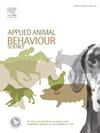IMTFF-Networks: A deep learning model for cattle behavior classification integrating multimodal time-frequency features
IF 2.2
2区 农林科学
Q1 AGRICULTURE, DAIRY & ANIMAL SCIENCE
引用次数: 0
Abstract
In modern livestock farming, understanding cattle behavior patterns is crucial for improving their health and production efficiency. For example, behaviors such as rumination (chewing food) and eating not only affect their health but also directly influence farm economic efficiency and food safety. However, these behaviors exhibit complex dynamic characteristics, showing significant nonlinearity and temporal dependence, which presents challenges in representing behavioral features for accurately capturing long-term dependencies and nonlinear relationships, thereby limiting classification accuracy. To address these challenges, we propose a deep learning model for cattle behavior classification Integrating Multimodal Time-Frequency Features (IMTFF-Networks). Compared to traditional deep learning models such as Long Short-Term Memory (LSTM) or Temporal Convolutional Networks (TCN), IMTFF-Networks can simultaneously capture both time-domain and frequency-domain features, overcoming the limitations of relying solely on time-domain or frequency-domain features when processing complex behavior patterns. IMTFF-Networks comprises modules for multimodal time-frequency fusion of sensor signals and multi-scale time-frequency feature analysis. The multimodal time-frequency fusion module integrates time-frequency features through Feature Mode Decomposition (FMD) and frequency domain processing, comprehensively capturing the dynamic characteristics of behavioral signals, such as frequency components and temporal patterns, thereby enhancing the accuracy and robustness of behavior recognition. The multi-scale time-frequency feature analysis module employs multi-scale temporal processing and attention mechanisms to capture long-term dependencies and complex nonlinear relationships among features across different time scales. The experiments were conducted using 3460 hours of behavioral data from 18 Limousin crossbred steer, encompassing rumination, eating, and other behavioral categories. The results demonstrate that IMTFF-Networks significantly outperforms methods relying solely on single time-domain or frequency-domain features in cattle behavior classification tasks. Specifically, IMTFF-Networks achieved an accuracy of 86.42 %, a balanced accuracy of 84.78 %, precision of 87.53 %, recall of 86.42 %, and F1 score of 86.64 % on the test set. This study not only validates the effectiveness of IMTFF-Networks in processing complex temporal data but also provides important references for future research in animal behavior monitoring.
IMTFF-Networks:整合多模态时频特征的牛行为分类深度学习模型
在现代畜牧业中,了解牛的行为模式对改善它们的健康和生产效率至关重要。例如,反刍(咀嚼食物)和进食等行为不仅影响他们的健康,而且直接影响农场经济效益和食品安全。然而,这些行为表现出复杂的动态特征,表现出显著的非线性和时间依赖性,这给准确捕获长期依赖关系和非线性关系的行为特征表示带来了挑战,从而限制了分类的准确性。为了解决这些挑战,我们提出了一种整合多模态时频特征(IMTFF-Networks)的牛行为分类深度学习模型。与长短期记忆(LSTM)或时间卷积网络(TCN)等传统深度学习模型相比,IMTFF-Networks可以同时捕获时域和频域特征,克服了在处理复杂行为模式时仅依赖时域或频域特征的局限性。IMTFF-Networks包括传感器信号的多模态时频融合和多尺度时频特征分析模块。多模态时频融合模块通过特征模态分解(Feature Mode Decomposition, FMD)和频域处理融合时频特征,全面捕捉行为信号的频率成分、时间模式等动态特征,从而提高行为识别的准确性和鲁棒性。多尺度时频特征分析模块采用多尺度时间处理和注意机制,捕捉不同时间尺度特征之间的长期依赖关系和复杂的非线性关系。实验使用了18头利穆赞杂交牛3460 小时的行为数据,包括反刍、进食和其他行为类别。结果表明,在牛的行为分类任务中,IMTFF-Networks显著优于仅依赖单一时域或频域特征的方法。具体来说,IMTFF-Networks在测试集上的准确率为86.42 %,平衡准确率为84.78 %,准确率为87.53 %,召回率为86.42 %,F1分数为86.64 %。本研究不仅验证了IMTFF-Networks处理复杂时间数据的有效性,也为今后动物行为监测的研究提供了重要参考。
本文章由计算机程序翻译,如有差异,请以英文原文为准。
求助全文
约1分钟内获得全文
求助全文
来源期刊

Applied Animal Behaviour Science
农林科学-行为科学
CiteScore
4.40
自引率
21.70%
发文量
191
审稿时长
18.1 weeks
期刊介绍:
This journal publishes relevant information on the behaviour of domesticated and utilized animals.
Topics covered include:
-Behaviour of farm, zoo and laboratory animals in relation to animal management and welfare
-Behaviour of companion animals in relation to behavioural problems, for example, in relation to the training of dogs for different purposes, in relation to behavioural problems
-Studies of the behaviour of wild animals when these studies are relevant from an applied perspective, for example in relation to wildlife management, pest management or nature conservation
-Methodological studies within relevant fields
The principal subjects are farm, companion and laboratory animals, including, of course, poultry. The journal also deals with the following animal subjects:
-Those involved in any farming system, e.g. deer, rabbits and fur-bearing animals
-Those in ANY form of confinement, e.g. zoos, safari parks and other forms of display
-Feral animals, and any animal species which impinge on farming operations, e.g. as causes of loss or damage
-Species used for hunting, recreation etc. may also be considered as acceptable subjects in some instances
-Laboratory animals, if the material relates to their behavioural requirements
 求助内容:
求助内容: 应助结果提醒方式:
应助结果提醒方式:


